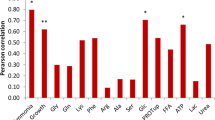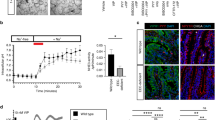Abstract
HYPERAMMONAEMIA is thought to be a cause of hepatic coma. Ammonium which is contributed to the general circulation by the alimentary tract is derived from the degradation of protein and urea1. Ammonium chloride is absorbed readily from the small intestine in vivo, but a more precise characterization of ammonium transport can come only from in vitro investigations. Our report provides preliminary data on the movement of ammonium ions across the small intestinal mucosa of the golden hamster.
This is a preview of subscription content, access via your institution
Access options
Subscribe to this journal
Receive 51 print issues and online access
$199.00 per year
only $3.90 per issue
Buy this article
- Purchase on Springer Link
- Instant access to full article PDF
Prices may be subject to local taxes which are calculated during checkout
Similar content being viewed by others
References
Walser, M., and Bodenlos, L. J., J. Clin. Invest., 38, 1617 (1959).
Wilson, T. H., and Wiseman, G., J. Physiol., 123, 116 (1954).
Umbreit, W. W., Burris, R. H., and Stauffer, J. F., Manometric Techniques, 132 (Burgess Publishing Co., Minneapolis, 1964).
Seligson, D., and Hirahara, K., J. Lab. and Clin. Med., 49, 962 (1957).
Mossberg, S. M., Thayer, jun., W. R., and Spiro, H. M., J. Lab. and Clin. Med., 61, 469 (1963).
Author information
Authors and Affiliations
Rights and permissions
About this article
Cite this article
MOSSBERG, S., ROSS, G. & WEINGARTEN, B. Transport of Ammonia by the Small Intestine of the Golden Hamster. Nature 212, 1588–1589 (1966). https://doi.org/10.1038/2121588b0
Published:
Issue Date:
DOI: https://doi.org/10.1038/2121588b0
Comments
By submitting a comment you agree to abide by our Terms and Community Guidelines. If you find something abusive or that does not comply with our terms or guidelines please flag it as inappropriate.



